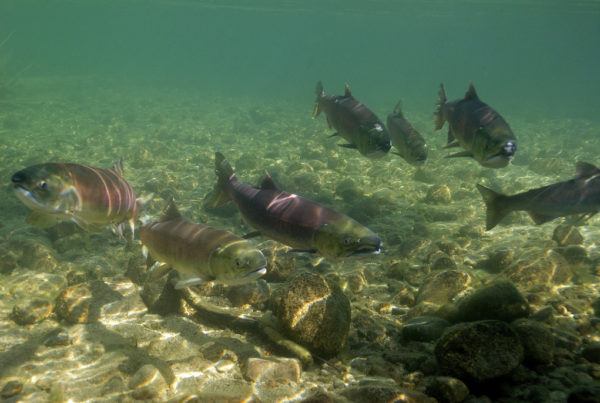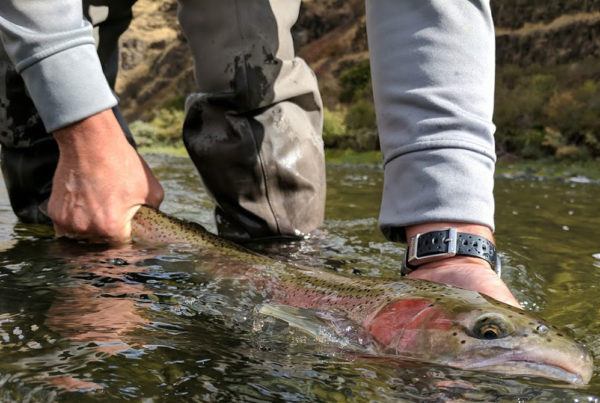Columbia Basin Bulletin, October 26, 2018
A Presidential memorandum released Friday, October 19, directs federal agencies to reduce regulations at West Coast dams, including water projects in California, the Klamath River and federal dams in the Columbia River basin.
One of President Donald J. Trump’s directives that is included in the memo is to move up by one year the completion of an environmental impact statement and biological opinion for salmon and steelhead that traverse the federal Columbia River power system’s eight Columbia and Snake river dams.
In his May 2016 remand of the 2014 FCRPS BiOp, U.S. District Court Judge Michael H. Simon directed NOAA Fisheries, the Bonneville Power Administration, the Bureau of Reclamation and the U.S. Army Corps of Engineers to complete the EIS and BiOp with a Record of Decision by September 2021. The Trump memo moves up the finish date for the EIS/BiOp to 2020.
Simon’s rejection of the 2014 BiOp was the fifth time a federal judge has rejected an FCRPS BiOp in a hydroelectric system that impacts thirteen species of salmon and steelhead listed as endangered or threatened under the federal Endangered Species Act. Previous challenged BiOps were in 2000, 2004, 2008 and a supplemental BiOp in 2010.
Even while on a schedule to complete a BiOp in 2021, NOAA Fisheries recently said it needs to also complete a BiOp by the end of this year to meet National Environmental Policy Act requirements for salmon and steelhead protections. NOAA had said in May the incidental take coverage for operation of the system expires at the end of 2018 and to ensure ESA compliance, it needs to complete a BiOp this year.
In addition, Simon ordered in April 2017 more spring spill at the lower Snake and lower Columbia river dams but delayed the action until 2018 while federal agencies completed a spill plan for the dams.
The memo (Promoting the Reliable Supply and Delivery of Water in the West), directs the secretaries of Commerce and Interior to “address water infrastructure challenges in the western United States.”
“Decades of uncoordinated, piecemeal regulatory actions have diminished the ability of our Federal infrastructure … to deliver water and power in an efficient, cost effective way,” the memo says.
“Unless addressed, fragmented regulation of water infrastructure will continue to produce inefficiencies, unnecessary burdens, and conflict among the Federal Government, States, tribes, and local public agencies that deliver water to their citizenry,” it says. “To meet these challenges, the Secretary of the Interior and the Secretary of Commerce should, to the extent permitted by law, work together to minimize unnecessary regulatory burdens and foster more efficient decision-making so that water projects are better able to meet the demands of their authorized purposes.”
For the Columbia River basin, the memo directs the secretaries of the Interior, Commerce, Energy and the Assistant Secretary of the Army for Civil Works under the direction of the Secretary of the Army, to develop a schedule to complete the FCRPS BiOp by 2020.
“The schedule shall be submitted to the Chair of the Council on Environmental Quality within 60 days of the date of this memorandum,” it says.
U.S. Representatives Cathy McMorris Rodgers (R-WA-5th District) and Rep. Dan Newhouse (R-WA- 4th District), applauded the Presidential memo, saying it brings certainty to the Columbia and Snake river systems.
“I’ve led on legislation to protect the Columbia and Snake River System and encourage widespread collaboration in our region,” said McMorris Rodgers. “Dams and fish coexist, and after more than two decades in the courtroom, we should let scientists, not judges, manage our river systems and get to work to further improve fish recovery efforts. Today, I’m encouraged by President Trump’s action, which also meets those goals.”
“While the Senate fails to act on our House-passed legislation to restore the collaborative framework that operates the Columbia and Snake River Power System, I am grateful to President Trump for speeding up this ongoing process,” said Newhouse. “Moving up the deadline for the EIS is a procedural win that will give more certainty to the communities whose livelihoods depend on effective operations of our dams.”
Others see the memo, which actually has little directive power, as pre-election politicking.
“The recent announcement from the President looks more like bad politics than good policy,” said Save Our Wild Salmon executive director Joseph Bogaard. “The fact remains that real solutions to the problems facing our communities and endangered salmon in the Northwest will only be resolved when people work together on shared solutions to common problems. Unfortunately, the recent announcement from the White House makes this kind of collaboration less likely rather than more likely.”
The memo also directs Commerce and Interior to identify projects in California for which the agencies hold joint responsibility for Endangered Species Act “to facilitate the designation of one official to coordinate the agencies’ ESA and NEPA compliance responsibilities.” NEPA is the National Environmental Policy Act.
It also gave the designated official 30 days to identify regulations and procedures that potentially burden the project and develop a proposed plan, “for consideration by the Secretaries, to appropriately suspend, revise, or rescind any regulations or procedures that unduly burden the project beyond the degree necessary to protect the public interest or otherwise comply with the law.”
The memo defined “burden” to mean “unnecessarily obstruct, delay, curtail, impede, or otherwise impose significant costs on the permitting, utilization, transmission, delivery, or supply of water resources and infrastructure.”
The Oct. 15 presidential memorandum is at: https://www.whitehouse.gov/presidential-actions/presidential-memorandum-promoting-reliable-supply-delivery-water-west/
In their joint news release, McMorris Rodgers and Newhouse said the BiOp overturned by Simon “has helped to produce record fish returns through use of modern, innovative technology, and has widespread support in the region. Unfortunately, a U.S. District judge overturned the BiOp in 2016, throwing out sound science and dictating new river operations from behind the bench—including maximum “spill” levels over the dams. The judge’s anti-science court order has thrown the river system’s operations into disarray and forced uncertainty upon the Bonneville Power Administration’s (BPA) ability to manage the power transmission system.”
The joint news release by McMorris Rogers and Newhouse is at https://mcmorris.house.gov/reps-mcmorris-rodgers-newhouse-applaud-white-house-plan-to-bring-certainty-to-columbia-and-snake-river-system/
Also see:
–CBB, July 27, 2018, “Court-Ordered Spill Completed In June; Corps Sends Judge Last Of Three Reports Detailing Operations,” http://www.cbbulletin.com/441186.aspx
— CBB, June 29, 2018, “Corps’ Second Spill Report To Court Details Impacts Of High Flows, Involuntary Spill In May,” http://www.cbbulletin.com/441024.aspx
–CBB, June 8, 2018, “NOAA Fisheries Delivers First Court-Ordered Spring Spill For Fish Report; Shows Complex Operations,” http://www.cbbulletin.com/440890.aspx
–CBB, June 1, 2018, “NOAA Says It Must Complete New Salmon/Steelhead BiOp In 2018 To Ensure ESA Compliance,” http://www.cbbulletin.com/440848.aspx
–CBB, April 13, 2018, “Court Ordered Spring Spill For Fish Begins On Four Lower Columbia River Dams,” http://www.cbbulletin.com/440516.aspx
— CBB, April 6, 2018, “New Court-Ordered Spill Regime Based On Dissolved Gas Caps Begins This Week,” http://www.cbbulletin.com/440479.aspx
–CBB, July 15, 2016, “Judge Gives Feds Nearly Five Years To Complete NEPA Process For New Basin Salmon/Steelhead Recovery,” http://www.cbbulletin.com/437139.aspx
–CBB, May 6, 2016, “Federal Court Again Rejects Columbia Basin Salmon/Steelhead Recovery Plan; Orders New BiOp By 2018,” http://www.cbbulletin.com/436667.aspx



















